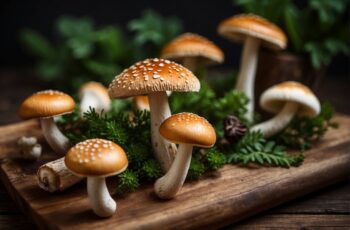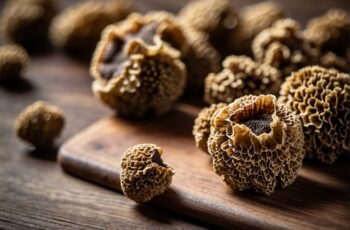Morel mushrooms are a popular delicacy among mushroom hunters and food enthusiasts in Oklahoma. These mushrooms are known for their unique appearance and flavor, making them a highly sought-after ingredient in many dishes. The morel mushroom season in Oklahoma typically starts around the last two weeks of March and lasts until mid-May, although the exact timing can vary depending on the weather conditions.
Morel mushrooms are found in a variety of habitats, including forests, riverbanks, and grasslands. In Oklahoma, they are commonly found in the eastern part of the state, particularly in areas with limestone or sandstone soils. Hunting for morel mushrooms can be a challenging and rewarding experience, as they can be difficult to spot and are often hidden among other vegetation.
Key Takeaways
- Morel mushrooms are a popular delicacy in Oklahoma, with a season that typically runs from late March to mid-May.
- These mushrooms are found in a variety of habitats, including forests and riverbanks, and are commonly found in the eastern part of the state.
- Hunting for morel mushrooms can be challenging, but the reward is a unique and flavorful ingredient for many dishes.
Understanding Morel Mushrooms
Morel mushrooms, also known as Morchella, are a popular edible species that can be found in Oklahoma. They have a unique appearance, with a honeycomb-like cap and stem. The cap can range in color from light yellow to dark brown, and the stem is usually white or light brown.
Morels have a distinct flavor that is often described as nutty or earthy. They are commonly used in various dishes, such as soups, stews, and sauces. However, it is important to note that some people may have an allergic reaction to morels, so it is recommended to consume them in moderation.
In Oklahoma, morel mushroom season typically starts in late March and lasts until mid-May. They thrive in humid and damp climates and are most prominent in the first couple of weeks of April. To increase your chances of finding them, it is important to consider certain factors such as soil type, surrounding trees, and the best time to search for them.
It is important to properly identify morels before consuming them, as there are some poisonous look-alike species. A false morel, for example, is typically red/brown in color and is full of fibrous tissue on the inside. It is also recommended to avoid eating uncooked morels.
Related Posts:
The Habitat of Morel Mushrooms in Oklahoma
Morel mushrooms are a highly prized edible mushroom found in Oklahoma. They grow in a variety of habitats, but are most commonly found in mixed forests of oak, hickory, and eastern red cedar. The morel mushroom season in Oklahoma usually starts around the last two weeks of March and lasts until mid-May.
Morel mushrooms require specific conditions to grow, including the right soil, temperature, and humidity. They prefer well-drained soil that is rich in organic matter and has a pH between 5.5 and 7.5. They grow best in temperatures between 50 and 60 degrees Fahrenheit and require high humidity levels.
Morel mushrooms are often found in shaded areas around mature trees, especially elm, oak, hickory, and ash trees. They also grow in riparian areas and in the cross timbers region of Oklahoma, which is characterized by a mix of hardwood and cedar trees. The leaf litter and debris in these areas provide an ideal environment for morels to grow.
Morel mushrooms are also known to grow in areas with a mycelial network, which is a network of fungal threads that spread throughout the soil. They are often found in areas where the mycelial network has been disturbed, such as after a fire or logging activity.
In summary, morel mushrooms in Oklahoma are commonly found in mixed forest habitats with well-drained soil, high humidity, and temperatures between 50 and 60 degrees Fahrenheit. They grow in shaded areas around mature trees, especially elm, oak, hickory, and ash trees, and are also found in riparian areas and the cross timbers region of Oklahoma.
Related Posts:
Hunting for Morel Mushrooms in Oklahoma
Morel mushroom hunting is a popular activity in Oklahoma during the spring season. The morel mushroom season in Oklahoma usually starts around the last two weeks of March and lasts until mid-May. However, the season can vary depending on weather conditions. Mushroom hunters are encouraged to take a mesh bag with them on their foraging excursions. Placing the morels in a bag with holes will allow morel spores to spread as the foragers continue to hike around. The morels will grow again in or near the same places the next year if the soil temperatures and rain are ideal.
Mushroom hunters can find morel mushrooms in both public and private lands. However, it is important to obtain permission from private landowners before entering their property. Fallen leaves and grassy areas are good places to look for morels. They can also be found near redbuds, aspen, and areas that have been affected by forest fires.
When foraging for morel mushrooms, it is important to be aware of ticks and poison ivy. Mushroom hunters should wear long pants, long-sleeved shirts, and boots to protect themselves. It is also important to bring a tick removal tool and a first aid kit.
Mushroom enthusiasts can also join the Oklahoma Mycological Society to learn more about identifying and collecting mushrooms. The society provides information on mushroom finds and reports in Oklahoma.
Related Posts:
Identifying and Cooking Morel Mushrooms
Morel mushrooms are a highly prized edible mushroom that can be found in Oklahoma. They have a nutty, earthy flavor and a meaty texture. However, it is important to note that there are poisonous look-alikes, such as the false morel (gyromitra), which can cause liver and kidney failure due to the presence of a neurotoxin. Therefore, it is essential to properly identify morels before consuming them.
Identification of morels can be tricky, but there are some key characteristics to look for. Morels have a distinctive honeycomb-like cap with pits and ridges that resemble a brain or a sponge. They can range in color from yellow to brown, with the yellow morel being the first to appear in the season. The cap of a true morel is completely attached to the stem, while the false morel has a cap that is only partially attached.
When cooking morels, it is important to clean them thoroughly by gently brushing off any dirt or debris. Some people prefer to soak them in saltwater for a few minutes to remove any bugs or critters that may have taken up residence in the pits and crevices. Morels can be sautéed in butter or olive oil and used in a variety of dishes, such as pasta, risotto, or omelets. They also pair well with cream cheese and bacon.
It is important to note that false morels should never be consumed, even when cooked. They contain a toxin known as monomethyl hydrazine (MMH), which can cause dizziness, vomiting, and in some cases even death. If there is any doubt about the identification of a mushroom, it is best to err on the side of caution and not consume it.
Related Posts:
The Science of Morel Mushrooms
Morel mushrooms, scientifically known as Morchella, are a type of edible fungus that are highly sought after for their unique taste and appearance. They are typically found in wooded areas, particularly around the base of elm and oak trees, and thrive in wet and warm spring weather conditions.
The morel mushroom has a distinctive honeycomb-like cap that is light to dark brown in color, with a hollow stem and a white spore print. They are often confused with false morels, which are toxic and can cause serious health problems if consumed. False morels, such as the Gyromitra species, have a wrinkled cap and a solid stem.
Morels are unique in that they have a complex life cycle that involves both a sexual state and an asexual state. They produce spores that are dispersed by the wind, and these spores can germinate in the soil to form a network of thread-like mycelium. The mycelium can then produce sclerotia, which are compact masses of mycelium that can survive in the soil for years.
When the conditions are right, the mycelium can produce fruiting bodies, which are the morel mushrooms that we see above ground. The fruiting bodies are the reproductive structures of the fungus, and they release spores that can germinate and start the life cycle over again.
The habitat of morel mushrooms is closely tied to the health of the trees they grow around. Healthy trees provide the necessary nutrients and moisture for the mycelium to thrive, while dead or dying trees can provide a food source for the fungus. The soil moisture content is also an important factor, as morels tend to grow in areas with high soil moisture.
In conclusion, morel mushrooms are a unique and fascinating fungus that are highly prized for their taste and appearance. Understanding the science behind their growth and development can help mushroom hunters identify and harvest them safely and sustainably.
Related Posts:
Frequently Asked Questions
Where can I find morel mushrooms in Oklahoma?
Morel mushrooms can be found in various locations throughout Oklahoma, but they are most commonly found in wooded areas with moist soil. Some popular areas for hunting morel mushrooms in Oklahoma include the Ozark Mountains, the Arbuckle Mountains, and the Wichita Mountains.
What is the best way to hunt for morel mushrooms?
The best way to hunt for morel mushrooms is to search for them in areas with moist soil and undergrowth. Morel mushrooms are often found near trees, particularly those that are dead or dying. It is important to be careful when hunting for morel mushrooms, as they can be difficult to spot and can blend in with their surroundings. Many hunters recommend using a walking stick to gently move leaves and undergrowth out of the way to better spot the mushrooms.
How much is a pound of morel mushrooms worth?
The price of morel mushrooms can vary depending on the location and the season. In Oklahoma, morel mushrooms can sell for anywhere from $20 to $60 per pound, depending on the quality and availability.
Are morel mushrooms safe to eat in Oklahoma?
Yes, morel mushrooms are safe to eat in Oklahoma as long as they are properly identified and cooked. It is important to be cautious when identifying wild mushrooms, as some can be poisonous. If you are unsure about the identification of a mushroom, it is best to err on the side of caution and not consume it.
What are some other edible mushrooms in Oklahoma?
In addition to morel mushrooms, there are several other edible mushrooms that can be found in Oklahoma, including chanterelles, oyster mushrooms, and shiitake mushrooms. However, it is important to properly identify any wild mushroom before consuming it.
When is the best time of year to hunt for morel mushrooms in Oklahoma?
The best time of year to hunt for morel mushrooms in Oklahoma is typically in the spring, from late March to early May. However, the exact timing can vary depending on weather conditions and other factors. It is important to keep an eye on soil and air temperatures, as well as moisture levels, to determine when the mushrooms are most likely to appear.


